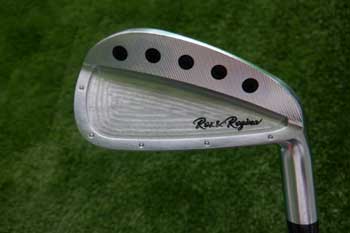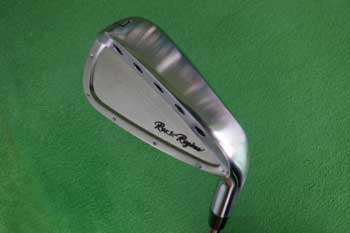
Today, I had the opportunity to test this golf club.
The test club is the JIGEN eBishop Iron, 7-iron model.

The shaft is the N.S.PRO MODUS3 TOUR120.
– Loft: 32°
– Club length: 36.75 inches
– Shaft flex: S
– Shaft weight: 114g
– Balance: D2
– Kick point: Mid-high
– Total club weight: 427g

This is my first time using a club from JIGEN.
Until recently, I had never heard of this manufacturer, but a friend introduced me to it.
There’s always a special excitement when testing a club from a brand I’ve never used before.

On the toe side, there is a small engraving that reads “JIGEN eBishop.”
When I hear “JIGEN,” I immediately think of Daisuke Jigen from *Lupin III*.
I wonder what the name actually means—perhaps it suggests that this club operates on a whole different “dimension” (*jigen* in Japanese)?
As for “Bishop,” I assume it refers to the chess piece, but I’m not entirely sure.

It is a **basic, simple cavity-back iron**.
Even though this is my first time using a JIGEN club, I have tested many similar irons over the years.
I can already visualize how it will perform.
The **back face design** is also quite traditional, and it reminds me of older Bridgestone irons.
The forged carbon steel finish is stunning and raises my excitement level just by looking at it.

The cavity is not particularly deep, making it a **standard half-cavity iron**.
Many modern irons integrate additional weights or composite materials, but I don’t see any foreign materials on this head.
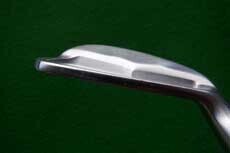
The top line thickness is standard.
Looking at it, it strongly reminds me of EPON irons.

The sole width is also standard.
Again, it has a design similar to EPON irons.
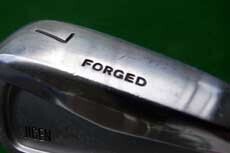
The sole has “FORGED” stamped on it.
These days, this kind of marking is more commonly found on the hosel, but it’s not unheard of.
The sole is an area that gets scratched and worn over time, so I personally feel that **keeping it clean and mark-free is ideal**.
After all, **the face and sole of an iron should reflect the golfer’s skill and play history**.
That said, very few golfers today use a single set of irons long enough for the soles to wear out completely.

The **sole shape** has a slight **rounded contour**, which should allow for **good turf interaction**.
This shape has been around for a long time and is nothing new, but it remains effective.

The **leading edge** is fairly standard, without any extreme beveling.

The **trailing edge** follows the same design principles—nothing extreme, just clean and functional.
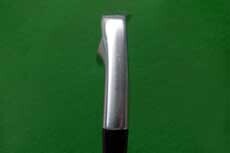
The neck length is very standard for modern irons.
Looking at this rear profile, I feel like I have seen this iron countless times before.
It reminds me of EPON and other top-tier forged irons.

The face has no milling, giving it a clean and simple look.
It does not have the **deep-cut grooves** seen on some irons, but the finishing is high quality.
The scoreline count is 12, which is one fewer than my usual reference point of 13, but it doesn’t bother me.

Taking some practice swings, I immediately felt comfortable.
The weight distribution and slight flexibility** of the shaft make it easy to time my swing.
With drivers, I look for a sense of flex and whip** to generate maximum distance.
However, **irons are about precision, not just power**.
I prefer **a stiffer, more direct** feeling when swinging irons.
That’s why **MODUS and Dynamic Gold** shafts are perfect for me.
Of course, steel shafts **do flex**, but the feel is different compared to graphite.
Lately, I’ve tested many irons with **lightweight shafts**, but today reaffirmed my belief that **a moderate-weight shaft is actually easier to control**.

The grip is **branded with the JIGEN logo**, which is a nice touch.
It has a **firm texture**, not a soft one.
The **high-friction surface** ensures excellent grip, similar to a **winter tire with strong tread**.
For me, it feels a bit too hard, and I prefer softer grips.
However, I know many golfers **prefer this kind of high-friction grip**.
This grip reminded me of the **JP Golf wedges** I tested previously.
It offers **excellent anti-slip performance**, which is the complete opposite of my preferred **Tour Velvet grips**.
There is no **right or wrong** choice—it’s simply a matter of **personal preference**.
Each golfer must **experiment and find what works best**.
Started Testing

The **impact feel** is soft and very satisfying.
Rather than a thin, clicky sensation, it provides a **substantial, solid feedback** that lets you feel the ball staying on the face for a split second before launching.
It delivers that **”catch and release” sensation** that many players seek in a forged iron.
Recently, many irons have started to emphasize **spring-like rebound** in their faces, which some golfers love.
However, **I personally prefer this type of soft, dense impact**.
This **is exactly the feel I expected** just by looking at the club.
With some **hollow-body irons**, the impact feel is completely different from their appearance.
However, with this iron, **the visuals match the feel perfectly**—it delivers on the promise its design suggests.

**Ball flight and launch characteristics** feel very standard.
This iron doesn’t seem to include any special technology to assist with launch.
With a **loft of 32°**, it is **stronger than my personal preference for a 7-iron** (which I typically set at 34° or weaker).
To me, this is actually a **6-iron loft**, and I personally prefer **traditional loft gapping**.
Recently, the **distinction between iron numbers and lofts has become quite vague**.
If this iron had “6” stamped instead of “7,” I think I would feel **even more enthusiastic** about it.
However, I understand that **many golfers today don’t care about these distinctions**.
I have always maintained that **a 7-iron should be 34° or weaker**.
This means I wouldn’t purchase this club **unless I had the loft adjusted**.
Of course, since it’s **forged**, I could easily bend the loft, but shifting by **2 degrees or more** might affect the lie angle and club balance.
I prefer irons that already have **proper loft gapping**, so I don’t need to modify them much.

**Forgiveness and Stability** feel **moderate**.
It offers **some margin for error**, but it’s not a super game-improvement iron.
For those used to **large, high-MOI irons**, this might feel a bit more **workable and precise**.
It provides enough **stability** while still **rewarding precision**.
The sweet spot feels **very concentrated**—meaning **off-center shots don’t get as much assistance**.
I feel that many golfers today **lean towards oversized heads**.
However, for those who struggle with **toe-side strikes**, **switching to a compact iron like this might actually improve consistency**.
Bigger does not always mean easier.
There are **advantages and disadvantages** to oversized irons.
While they can be more forgiving on mishits, they can also **introduce control issues**, especially in skilled players looking for precision.

**Workability** is **excellent**.
As expected, **this iron allows for smooth shot shaping**.
I had **so much fun** working the ball left and right.
The club responds very well to **both fades and draws**.
This test reaffirmed the importance of **a balanced head shape and good ball compression** for workability.
Of course, shaft characteristics also play a major role in shot shaping.
This iron is completely **manual**—meaning it doesn’t automatically “correct” ball flight for you.
For players who find **fully automatic, game-improvement irons too dull**, this one offers **a rewarding experience**.
Since it is **a cavity-back**, it’s more forgiving than a **blade**, but it still retains **a good balance of precision and forgiveness**.
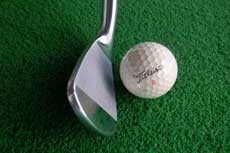
**Distance performance** is **slightly above average**.
It plays about **one club longer than traditional irons**.
However, by today’s standards, it would be considered **moderate** rather than an extreme distance iron.
If you don’t want **excessive distance but still want a slight boost**, this could be a good option.
This iron is better suited for **consistency and trajectory control** rather than **maximizing distance**.
Final Thoughts After Testing

This iron is **beautiful and stylish**.
The **aesthetic appeal** of a club is **a fundamental part of performance**.
Golf is a sport that thrives on **excitement and anticipation**.
Using a **visually stunning** club can enhance your **enjoyment and mental focus**, which in turn **improves your overall game**.

A while ago, **stainless steel irons** became quite popular.
However, **forged carbon steel irons** have made a strong comeback in recent years.
Many golfers seem to be rediscovering the **unique advantages** of **soft, responsive forged irons**.
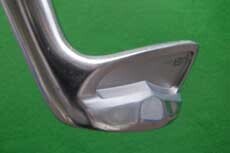
The **biggest advantage of forged irons**, in my opinion, is **customization**.
Being able to **adjust loft and lie angles** with ease is a game-changer.
Many golfers struggle with **directional control** simply because their **lie angles aren’t properly fitted**.
This is why **post-purchase adjustments** are essential.
With a **forged iron**, these adjustments are **quick and easy**—a skilled club fitter can make them in **seconds**.

Some golfers **never check their lie angles**.
Many believe **high-tech club features** are the key to performance.
However, **a simple lie angle adjustment** can sometimes **do more to improve your game** than all the fancy weight ports and adjustable hosels.
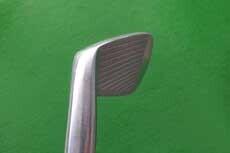
This is why **I never buy stainless steel irons**.
They **lack the adjustability** that makes forged irons so appealing.
Stainless steel is **more durable**, but in the **long run**, I believe **forged irons offer superior benefits**.
Regardless of how golf clubs evolve in the future, **forged irons will always have a place in the game**.

Even though this was my **first time using a JIGEN iron**, it felt **very familiar**.
This iron **doesn’t introduce any groundbreaking changes**.
However, that’s **not a flaw—it’s a strength**.
It incorporates **all the essential elements of a great iron** and **executes them perfectly**.
For golfers looking to **sharpen their feel and shot-making**, **this iron is a fantastic choice**.
In short, **simple is best**.
☆
Ease of setup: ☆☆☆☆☆
Feel: ☆☆☆☆☆
Launch ease: ☆☆☆
Stability: ☆☆☆
Distance performance: ☆☆☆
Workability: ☆☆☆☆
※ After trying it out, I researched this club.
JIGEN eBishop Iron Review: A Premium Iron for Precision Golfers
Introduction
When it comes to elite golf equipment, JIGEN may not be the first name that comes to mind for many golfers. However, for those deeply immersed in the world of high-performance clubs, JIGEN’s dedication to precision and craftsmanship is well-known. The JIGEN eBishop Iron is a club designed for golfers who demand unparalleled control, consistency, and feedback from their irons. In this comprehensive review, we will explore every aspect of this iron, from its design and materials to performance and suitability for different types of golfers.
If you’re looking for the best golf clubs that offer an exceptional balance between traditional craftsmanship and modern technology, the JIGEN eBishop Iron might be the perfect choice. We’ll also discuss how a well-fitted iron can improve your performance through golf swing tips and how this club fares in professional golf equipment reviews.
Design and Build Quality
1. Aesthetics and Craftsmanship
One of the most striking aspects of the JIGEN eBishop Iron is its elegant yet aggressive design. The clubhead features a sleek, compact shape with a thin topline and minimal offset, catering to skilled players who prefer a traditional blade-like appearance. The combination of a forged soft carbon steel body with precision-milled detailing ensures that every aspect of this club is designed with performance in mind.
Premium Finish: The brushed chrome finish reduces glare and provides a sophisticated look.
Compact Blade Profile: Designed for players who appreciate a clean, uncluttered appearance at address.
Engraved Cavity Design: Enhances weight distribution while maintaining a classic look.
2. Forged Construction and Material Choice
JIGEN has employed S20C forged carbon steel, a material renowned for its soft feel and durability. Forging the club ensures a dense, responsive structure, offering golfers better energy transfer at impact.
Soft yet responsive feel for players who rely on feedback.
Consistent grain structure, reducing unnecessary vibrations.
Precision CNC milling, enhancing groove sharpness and ball control.
Performance and Playability
1. Ball Striking and Control
For skilled players, an iron must offer both workability and precision. The JIGEN eBishop Iron is built for high control and shot-shaping, making it ideal for golfers who prefer to manipulate their ball flight.
High MOI (Moment of Inertia): Provides stability on off-center strikes without sacrificing workability.
Optimized CG (Center of Gravity): Lowered to allow for higher launch and controlled landing angles.
Tight Dispersion: Even on mishits, the club maintains a compact shot dispersion, keeping your shots within striking distance of the target.
2. Distance and Forgiveness
While many game-improvement irons prioritize distance, the eBishop is more about precision. However, thanks to the advanced weight distribution and perimeter weighting, players won’t sacrifice much yardage.
Consistent distance control, crucial for shot accuracy.
Moderate forgiveness: While not as forgiving as cavity-back irons, the eBishop offers enough stability to assist even minor mishits.
Who Should Play the JIGEN eBishop Iron?
The eBishop Iron is a players’ iron, meaning it is best suited for golfers with a single-digit handicap or those aspiring to develop their shot-making skills. Here’s a breakdown of the ideal golfer for this club:
1. Skilled Ball Strikers
Players who prefer feedback on every shot.
Those who control spin and ball flight actively.
Golfers who enjoy shaping shots rather than relying on automatic forgiveness.
2. Traditionalists Looking for Workability
Players who appreciate classic blade aesthetics.
Those who want low offset and a thin topline for precision aiming.
3. Mid-Handicappers Looking to Improve
Players transitioning from game-improvement irons to a more traditional set.
Those willing to sacrifice some forgiveness for enhanced accuracy.
Pros and Cons of the JIGEN eBishop Iron
Pros
✅ Exceptional craftsmanship: Forged S20C carbon steel provides an unbeatable soft feel.
✅ Superior control: Tight shot dispersion and workability.
✅ Clean aesthetics: Traditional blade look for confident address.
✅ Responsive feedback: Provides immediate information on strike quality.
✅ Consistent performance: Excellent spin control and predictable ball flight.
Cons
❌ Not as forgiving: Mishits are more penalizing compared to cavity-back designs.
❌ Not for beginners: Requires consistent ball-striking ability.
❌ Price: Premium pricing may deter budget-conscious golfers.
Comparisons with Other High-End Irons
JIGEN eBishop vs. Titleist T100
Feel: eBishop provides a slightly softer, more traditional forged feel.
Forgiveness: T100 offers more forgiveness due to multi-material construction.
Workability: Both irons excel, but eBishop has a slightly lower launch and more penetrating ball flight.
JIGEN eBishop vs. Mizuno MP-223
Aesthetics: eBishop is more traditional, whereas MP-223 has a slightly more modern look.
Performance: MP-223 is more forgiving, while eBishop offers better shot feedback.
Final Thoughts: Is the JIGEN eBishop Iron Worth It?
The JIGEN eBishop Iron is a remarkable piece of golf equipment designed for elite players who value precision and control. While it is not the most forgiving iron on the market, it is undoubtedly one of the best golf clubs for skilled ball strikers.
For those considering an iron upgrade, we highly recommend scheduling a golf club fitting to determine if the eBishop suits your swing mechanics. A properly fitted iron can significantly enhance your performance, making a profound difference in your game.
Final Verdict:
⭐ Feel: 10/10⭐ Control: 9/10⭐ Forgiveness: 6/10⭐ Aesthetics: 10/10⭐ Overall Performance: 9/10
If you are an experienced golfer who thrives on control and precision, the JIGEN eBishop Iron is a club that will undoubtedly elevate your game. However, if you need extra forgiveness, exploring alternatives like the Titleist T100 or Mizuno MP-223 might be a better choice.
For more golf equipment reviews, swing tips, and club fitting guides, stay tuned for our latest updates! Happy golfing! ⛳





